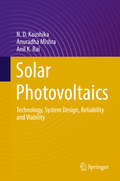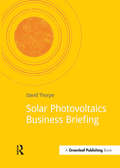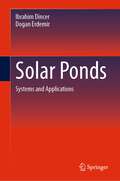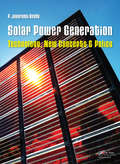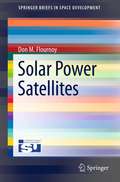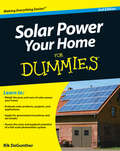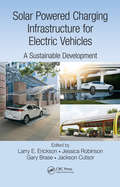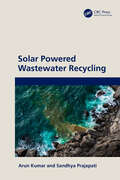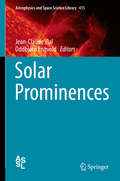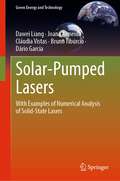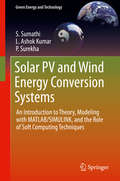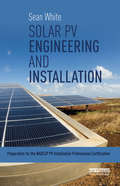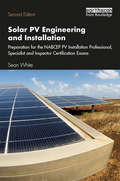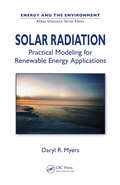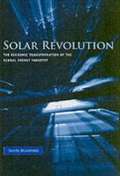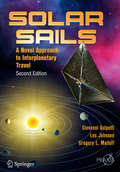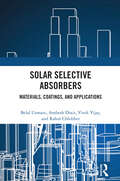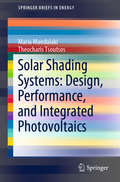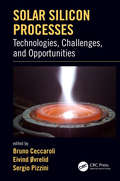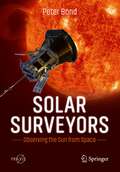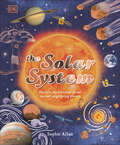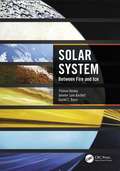- Table View
- List View
Solar Photovoltaics: Technology, System Design, Reliability And Viability
by N. D. Kaushika Anuradha Mishra Anil K. RaiThis book presents a quantitative description of the physics of solar-cell materials, transport processes, fabrication methods, and offers a scientific understanding of the technology involved. It also presents the current knowledge of the electrical characteristics of modules arrays and balance of systems (BOS) for a wide spectrum of applications. It particularly focuses on solar-powered communication systems and building integrated photovoltaic (BIPV) systems, exploring the reliability and viability aspects in detail. The book is of interest to application engineers, practitioners in private and government agencies, as well as graduate and postgraduate students.
Solar Photovoltaics Business Briefing (Doshorts Ser.)
by David ThorpeThis book explains, for a UK business audience, the technical, scientific and economic aspects of solar photovoltaics (PV) technologies. It is useful to anyone considering a business use of solar PV, whether an investor, potential purchaser, or thinking of setting up a company in the sector.It succinctly examines: their applications and how to assess them; the prospects and drivers for cost reductions and implementation; the role of PV in carbon offsetting; and the business case for and against investment.It will arm the reader with sufficient knowledge to talk to contractors or to compile a business investment case for senior management.PV is the sunrise sector for electricity generation; the renewable technology whose time has come. Clean, and with no moving parts to wear out, it interfaces neatly with other technologies, both digital and analogue. Cost curves are decreasing and installation curves exponentially rising. Although silicon-based cells are well-known, due to the feed-in tariff support they receive, within the next five to eight years, lowering production costs and technological innovations will mean that solar electricity will be poised to find even more widespread applications.
Solar Ponds: Systems and Applications
by Ibrahim Dincer Dogan ErdemirThis book is about solar ponds for energy storage from various perspectives, including fundamentals, efficiencies, system designs, local applications and details about what have been done in the world in the field of solar ponds for generating energy and storage it for useful purposes.
Solar Power Generation: Technology, New Concepts & Policy
by P. Jayarama ReddyThis book offers a global perspective of the current state of affairs in the field of solar power engineering. In four parts, this well-researched volume informs about:Established solar PV (photovoltaic) technologiesThird-generation PV technologies based on new materials with potential for low-cost large-scale productionSolar cell technology based
Solar Power Generation Problems, Solutions, and Monitoring
by Peter GevorkianSolar Power Generation Problems, Solutions and Monitoring is a valuable resource for researchers, professionals and graduate students interested in solar power system design. Written to serve as a pragmatic resource for solar photovoltaic power systems financing, it outlines real-life, straightforward design methodology. Using numerous examples, illustrations and an easy to follow design methodology, Dr Peter Gevorkian discusses some of the most significant issues that concern solar power generation including: power output; energy monitoring and energy output enhancement; fault detection; fire and life safety hazard mitigation; and detailed hardware, firmware and software analytic solutions required to resolve solar power technology shortcomings. This essential reference also highlights the significant issues associated with large scale solar photovoltaic and solar power generation technology covering design, construction, deployment and fault detection monitoring as well as life safety hazards.
Solar Power Satellites
by Don M. FlournoyCommunication satellites are a $144 billion industry. Is there any space-based industry that could possibly beat that market? 'Solar Power Satellites' shows why and how the space satellite industry will soon begin expanding its market from relaying signals to Earth to generating energy in space and delivering it to the ground as electricity. In all industrialized nations, energy demand is growing exponentially. In the developing world, the need for energy is as basic as food and water. The Sun's energy is available everywhere, and it is non-polluting. As business plans demonstrate its technical feasibility, commercial potential, and environmental acceptability, every country on Earth will look to space for the power it needs.
Solar Power (World About Us)
by Sarah LeveteDescribes Solar Energy, what it is, how we can use it to help protect our planet. for younger readers
Solar Power Your Home For Dummies
by Rik DeguntherThe bestselling alternative energy reference book in North America--now in an updated editionWant to take advantage of solar power in your home? Whether you're looking to save on your energy costs by adding a few solar components or you want to build a solar-powered house from the ground up, Solar Power For Dummies, 2nd Edition takes the mystery out of this energy source and shows you how to put it to work for you!This new edition gives you hands-on tips and techniques for making your home more energy-efficient though solar power--and helping the planet at the same time. Plus, you'll get all the latest information on changes to federal, state, and local regulations, laws, and tax incentives that seek to make solar-power adoption more feasible.Expanded coverage of the technology that underpins full-scale solar-power systems for the homeNew small- and mid-sized solar products, projects, and applicationsRik DeGunther is a design engineer who started his own energy consulting firmFeaturing ten of the easiest and cheapest DIY solar projects, Solar Power For Dummies, 2nd Edition is the fun and easy way to meet your energy needs with this clean power source!
Solar Powered Charging Infrastructure for Electric Vehicles: A Sustainable Development
by David Morley, Xiaoming Li, Crispin JenkinsonThe Paris Agreement on Climate Change adopted on December 12, 2015 is a voluntary effort to reduce greenhouse gas emissions. In order to reach the goals of this agreement, there is a need to generate electricity without greenhouse gas emissions and to electrify transportation. An infrastructure of SPCSs can help accomplish both of these transitions. Globally, expenditures associated with the generation, transmission, and use of electricity are more than one trillion dollars per year. Annual transportation expenditures are also more than one trillion dollars per year. Almost everyone will be impacted by these changes in transportation, solar power generation, and smart grid developments. The benefits of reducing greenhouse gas emissions will differ with location, but all will be impacted. This book is about the benefits associated with adding solar panels to parking lots to generate electricity, reduce greenhouse gas emissions, and provide shade and shelter from rain and snow. The electricity can flow into the power grid or be used to charge electric vehicles (EVs). Solar powered charging stations (SPCSs) are already in many parking lots in many countries of the world. The prices of solar panels have decreased recently, and about 30% of the new U.S. electrical generating capacity in 2015 was from solar energy. More than one million EVs are in service in 2016, and there are significant benefits associated with a convenient charging infrastructure of SPCSs to support transportation with electric vehicles. Solar Powered Charging Infrastructure for Electric Vehicles: A Sustainable Development aims to share information on pathways from our present situation to a world with a more sustainable transportation system with EVs, SPCSs, a modernized smart power grid with energy storage, reduced greenhouse gas emissions, and better urban air quality. Covering 200 million parking spaces with solar panels can generate about 1/4 of the electricity that was generated in 2014 in the United States. Millions of EVs with 20 to 50 kWh of battery storage can help with the transition to wind and solar power generation through owners responding to time-of-use prices. Written for all audiences, high school and college teachers and students, those in industry and government, and those involved in community issues will benefit by learning more about the topics addressed in the book. Those working with electrical power and transportation, who will be in the middle of the transition, will want to learn about all of the challenges and developments that are addressed here.
A Solar-Powered Planet (Into Reading, Level V #59)
by Jill McDougall Bill WoodNIMAC-sourced textbook.
Solar Powered Wastewater Recycling
by Arun Kumar Sandhya PrajapatiThe United Nations predicts that by the year 2025, two-thirds of the world’s population will face water scarcity. Further, the planet would have well over eight billion people, the majority of whom would live in developing countries, where more than 80% of those are already experiencing water scarcity. Therefore, there is an urgent need for wastewater recycling to help solve issues of scarcity and to facilitate better management of generated wastewater. Water recycling includes reuse and treatment of municipal wastewater, which could be a sustainable approach for environmental sustainability and could also help to offset the increasing water demands for irrigation and industrial and other needs. Currently, water and wastewater treatment facilities consume large amounts of energy that are mainly generated through the use of fossil fuels. Solar Powered Wastewater Recycling examines how solar power can be implemented as an integrated approach whereby all the energy needs of the water and wastewater sector could be supplemented by renewable technologies, and in which a synergy can be developed between water and energy.
Solar Prominences
by Jean-Claude Vial Oddbjørn EngvoldThis volume presents the latest research results on solar prominences, including new developments on e. g. chirality, fine structure, magnetism, diagnostic tools and relevant solar plasma physics. In 1875 solar prominences, as seen out of the solar limb, were described by P. A. Secchi in his book Le Soleil as "gigantic pink or peach-flower coloured flames". The development of spectroscopy, coronagraphy and polarimetry brought tremendous observational advances in the twentieth century. The authors present and discuss exciting new challenges (resulting from observations made by space and ground-based telescopes in the 1990s and the first decade of the 21st century) concerning the diagnostics of prominences, their formation, their life time and their eruption along with their impact in the heliosphere (including the Earth). The book starts with a general introduction of the prominence "object" with some historical background on observations and instrumentation. In the next chapter, the various forms of prominences are described with a thorough attempt of classification. Their thermodynamic (and velocity) properties are then derived with emphasis on the methods (and their limits) used. This goes from the simplest optically thin case to the heavy radiative treatment of plasmas out of local thermodynamic equilibrium. The following chapters are devoted to the magnetic field measurements and indirect derivation. A new branch of diagnostic tools, the seismology, is presented along with some MHD basics. This allows to better understand the propagation of waves, the energy and force equilibria. Both small-scale and large-scale studies and their relationship are presented. The importance of the newly discovered cavities is stressed in the context of prominence destabilization. The issues of prominence formation and eruption, their connection with flares and Coronal Mass Ejections and their impact on the Earth are addressed on the basis of the latest results. Finally, an exciting new area of research is unveiled with the newly discovered evidence of similar manifestations in the Universe and their possible impact on the habitability of exoplanets. References to the basic physics (where necessary) are provided and the proposed web sites addresses will allow the reader to load exciting movies. The book is aimed at advanced students in astrophysics, post-graduates, solar physicists and more generally astrophysicists. Amateurs will enjoy the many new images which go with the text.
Solar-Pumped Lasers: With Examples of Numerical Analysis of Solid-State Lasers (Green Energy and Technology)
by Dawei Liang Joana Almeida Cláudia Vistas Bruno Tibúrcio Dário GarciaThis textbook is a comprehensive review of many different areas in solar-pumped lasers design and characterization. It enables readers to develop their skills in general solid-state laser design and solar collector design and provides numerous solved exercises at the end of each chapter to further this development. This book begins by introducing the brief history of solar-pumped laser and its potential applications. It explains the basic theories of imaging and non-imaging primary, secondary, and tertiary solar concentrators. It discusses solar-pumped solid-state laser theory and solar-to-laser power conversion efficiencies. There are chapters dedicated to ZEMAX and LASCAD numerical simulation tools, to help develop readers’ skills in innovative solid-state laser design. This book is one of the first books to relate concentrated solar energy technologies to solid-state laser technologies and is therefore of interest to students, academics, engineers, and laser and optical system designers.
Solar PV and Wind Energy Conversion Systems
by S. Sumathi L. Ashok Kumar P. SurekhaThis textbook starts with a review of the principles of operation, modeling and control of common solar energy and wind-power generation systems before moving on to discuss grid compatibility, power quality issues and hybrid models of Solar PV and Wind Energy Conversion Systems (WECS). MATLAB/SIMULINK models of fuel cell technology and associated converters are discussed in detail. The impact of soft computing techniques such as neural networks, fuzzy logic and genetic algorithms in the context of solar and wind energy is explained with practical implementation using MATLAB/SIMULINK models. This book is intended for final year undergraduate, post-graduate and research students interested in understanding the modeling and control of Solar PV and Wind Energy Conversion Systems based on MATLAB/SIMULINK. - Each chapter includes "Learning Objectives" at the start, a "Summary" at the end and helpful Review Questions - Includes MATLAB/SIMULINK models of different control strategies for power conditioning units in the context of Solar PV - Presents soft computing techniques for Solar PV and WECS, as well as MATLAB/SIMULINK models, e. g. for wind turbine topologies and grid integration - Covers hybrid solar PV and Wind Energy Conversion Systems with converters and MATLAB/SIMULINK models - Reviews harmonic reduction in Solar PV and Wind Energy Conversion Systems in connection with power quality issues - Covers fuel cells and converters with implementation using MATLAB/SIMULINK
Solar PV Engineering and Installation: Preparation for the NABCEP PV Installation Professional Certification
by Sean WhiteThe NABCEP PV Installation Professional Exam is the gold standard certification exam for PV professionals and is famously difficult to pass. This book will provide test-taking strategy that can be used to most effectively study for and pass the exam. Code and theory is explained in the first half and will prove as useful background for the heart of the book which consists of practice exam questions and detailed explanations of the answers. It also contains essential strategy tools, short term memory tips and recommended reading which will be invaluable for anyone studying for the exam. The material in this book is not limited to those taking the exam as it will also be, more broadly, important for career progression and helping the reader to work safely with code compliant PV systems.
Solar PV Engineering and Installation: Preparation for the NABCEP PV Installation Professional, Specialist and Inspector Certification Exams
by Sean WhiteThe NABCEP PV Installation Professional (PVIP) Exam is the gold standard certification exam for PV professionals and is famously difficult to pass. As the industry grows and jobs have become more specialized, the Board has responded to this with NABCEP Specialist Certification Exams. As well as the content of the PVIP, this book also covers the material in the Design, Installer and Commissioning & Maintenance Specialist Certification Exams, and provides test-taking strategy that can be used to most effectively study for and pass these assessments. Code and theory is explained in the first half of this guide, acting as a useful background for the second half, which consists of practice exam questions and answers, complete with detailed explanations. It also contains essential strategy tools, short-term memory tips and recommended reading which will be invaluable for anyone studying for the exams. The material covered in this book is not limited to those taking the test, but will also act as a valuable tool for career progression, helping the reader to work safely with code-compliant PV systems. This second edition has been fully revised and updated to reflect the new developments in solar and energy storage systems and new technologies.
Solar Radiation: Practical Modeling for Renewable Energy Applications
by Daryl Ronald MyersWritten by a leading scientist with over 35 years of experience working at the National Renewable Energy Laboratory (NREL), Solar Radiation: Practical Modeling for Renewable Energy Applications brings together the most widely used, easily implemented concepts and models for estimating broadband and spectral solar radiation data. The author addresses various technical and practical questions about the accuracy of solar radiation measurements and modeling. While the focus is on engineering models and results, the book does review the fundamentals of solar radiation modeling and solar radiation measurements. It also examines the accuracy of solar radiation modeling and measurements. The majority of the book describes the most popular simple models for estimating broadband and spectral solar resources available to flat plate, concentrating, photovoltaic, solar thermal, and daylighting engineering designs. Sufficient detail is provided for readers to implement the models in assorted development environments. Covering the nuts and bolts of practical solar radiation modeling applications, this book helps readers translate solar radiation data into viable, real-world renewable energy applications. It answers many how-to questions relating to solar energy conversion systems, solar daylighting, energy efficiency of buildings, and other solar radiation applications.
Solar Revolution The Economic Transformation of the Global Energy Industry.
by Travis BradfordThis is a timely and much-needed book. The solar industry is evolving with dramatic speed, both technologically and economically. With a business perspective and a wealth of knowledge about the solar industry and the wider energy economy, Travis Bradford provides an excellent account of solar energy today. This book is a rigorous but intensely practical analysis of how the world's energy future should evolve. It will be valuable not only for scholars dealing with the technological and policy aspects of energy, but also for the concerned citizen who may have no specialized knowledge of the issues. Solar Revolution should receive worldwide attention for exploring the pathways that can guide the world towards a renewable energy future.
Solar Sails
by Giovanni Vulpetti Les Johnson Gregory L. MatloffThe reality of sunlight-based sailing in space began in May 2010, and solar sail technology and science have continued to evolve rapidly through new space missions. Using the power of the Sun's light for regular travel propulsion will be the next major leap forward in our journey to other worlds. This book is the second edition of the fascinating explanation of solar sails, how they work and how they will be used in the exploration of space. Updated with 35% new material, this second edition includes three new chapters on missions operated by Japan and the US, as well as projects that are in progress. The remainder of the book describes the heritage of exploration in water-borne sailing ships and the evolution to space-vehicle propulsion; as well as nuclear, solar-electric, nuclear-electric and antimatter rocket devices. It also discusses various sail systems that may use either sunlight or solar wind, and the design, fabrication and steering challenges associated with solar sails. The first edition was met with overwhelmingly positive reviews, and deemed "a title that needs to be on your shelf if you're seriously interested in the next step as we move beyond rocketry" (Centauri Dreams, September 2008). Written with a mixed approach, this book appeals to both the general public as well as those with a more scientifically technical background.
Solar Selective Absorbers: Materials, Coatings, and Applications
by Belal Usmani Ambesh Dixit Vivek Vijay Rahul ChhibberSolar Selective Absorbers: Materials, Coatings, and Applications covers different harnessing technologies for solar energy, electromagnetic radiation including design principles, and different types of spectrally selective coatings.The book emphasizes experimental methods for synthesizing these coating structures and characterization techniques to quantify the absorber characteristics, suitable for solar thermal applications. It also provides a compact review of the literature on solar (spectrally) selective absorber materials and coatings. Summarizes the materials, deposition and characterization techniques, and applications of solar selective absorbers Introduces solar selective absorber materials and photothermal technology Explores electrodeposition techniques and their use in the development of solar selective absorber films Provides understanding of solar selective absorber materials and coating techniques in photothermal technology Explains sputtering techniques and their use in the development of ZrO2/ZrC-ZrN/Zr tandem structure-based solar selective absorber films The book is aimed at researchers and graduate students in solar energy, solar thermal conversion, and materials science.
Solar Shading Systems: Design, Performance, and Integrated Photovoltaics (SpringerBriefs in Energy)
by Maria Mandalaki Theocharis TsoutsosThis is the first book to describe the development of and state of the art in solar shading devices in buildings, detailing all methods of evaluating shading systems according to thermal and visual comfort. The issue of energy balance in buildings is gaining importance as conventional energy sources dwindle and become more expensive. As such, environmental concerns should be considered in overall design decisions. The book discusses the role sun control “machines” play in controlling solar and thermal radiation. It examines their geometry, their position in relation to glazing and their operation (in the cases of movable systems) to control the heat and light entering a building, as well as how their material and color influence their performance. This book appeals to architects and designers who are interested in efficient energy facade design.
Solar Silicon Processes: Technologies, Challenges, and Opportunities
by Bruno Ceccaroli Eivind Øvrelid Sergio PizziniPolycrystalline silicon (commonly called "polysilicon") is the material of choice for photovoltaic (PV) applications. Polysilicon is the purest synthetic material on the market, though its processing through gas purification and decomposition (commonly called "Siemens" process) carries high environmental risk. While many current optoelectronic applications require high purity, PV applications do not and therefore alternate processes and materials are being explored for PV grade silicon. Solar Silicon Processes: Technologies, Challenges, and Opportunities reviews current and potential future processing technologies for PV applications of solar silicon. It describes alternative processes and issues of material purity, cost, and environmental impact. It covers limits of silicon use with respect to high-efficiency solar cells and challenges arising from R&D activities. The book also defines purity requirements and purification processes of metallurgical grade silicon (MG-Si) and examines production of solar grade silicon by novel processes directly from MG-Si and/or by decomposition of silane gas in a fluidized bed reactor (FBR). Furthermore, the book: Analyzes past research and industrial development of low-cost silicon processes in view of understanding future trends in this field. Discusses challenges and probability of success of various solar silicon processes. Covers processes that are more environmentally sensitive. Describes limits of silicon use with respect to high-efficiency solar cells and challenges arising from R&D activities. Defines purity requirements and purification processes of MG-Si. Examines production of solar grade silicon directly from MG-Si.
Solar Surveyors: Observing the Sun from Space (Springer Praxis Books)
by Peter BondThis is the story of humankind’s quest over centuries to learn the true nature of the most dominant object in our Solar System: the Sun.Award-winning science writer Peter Bond describes in detail how our ideas about the Sun have changed over the millennia, starting with the simple observations of classical astronomy and continuing through telescopic observations to the age of nuclear physics. He shows how we discovered the Sun’s basic characteristics – its distance, size, temperature and composition – and then describes how, with evermore sophisticated instruments, we have learned about the Sun’s enormous energy output, its atmosphere and the explosive eruptions that blast clouds of magnetized gas and high-energy particles toward our world.Most of this book focuses on the Space Age, when suborbital rockets and satellites have probed every aspect of our nearby star. Each of these missions is described in detail, with summaries of their objectives, spacecraft designs, scientific payloads and results. The book also looks forward, describing forthcoming missions that will shed new light on remaining solar mysteries, notably the source of the energy that heats the outer corona to millions of degrees.Richly illustrated with mission photos, design diagrams, and infocharts, this book is a fascinating read for anybody interested in the Sun and our attempts to unravel its secrets.
The Solar System: Discover the mysteries of our sun and neighboring planets (Space Explorers)
by Sophie AllanDiscover our expansive solar system in this breathtaking journey into space. This charming book is the perfect introduction for young readers who want to learn about our local star - the Sun - and the planets that orbit it. The Solar System covers space in thrilling detail and is the perfect book for space lovers everywhere. Packed with mind-blowing facts, this incredible book of the solar system is perfect for space lovers everywhere. This fascinating guide introduces 7-9 year-olds to the birth of the Sun and the solar system, then continues on a journey through space. They discover the smallest planet, rocky Mercury, which is closest to the Sun, and Venus, the hottest planet. There is also Mars, with its polar ice caps and volcanoes, and Jupiter, with its swirling storm clouds. Then readers venture further into space to explore the icy giants of outer space. This wonderful solar system book offers:- In-depth information, backed up by space photography, probe images, illustrations, and fun diagrams.- Striking illustrations, making this title a perfect gift, as well as a solid reference book. - Easy-to-digest sections, each filled with incredible facts and visuals.STEM learning, with key topics for 7-9 year-olds: labeled images of each of the planets, clear step-by-step visuals to show the birth of our solar system, accessible facts about space missions.Boasting beautiful illustrations by artist Dawn Cooper, combined with up-to-date images from space agencies such as NASA and ESA, info panels, timelines, and diagrams, that help demystify and explain the spectacles of space, this is the ideal book for budding astronauts.At DK, we believe in the power of discovery.So why stop there?If you like The Solar System, then why not complete the collection? Take a trip into space and discover the mysteries of Earth&’s closest neighbor with The Moon. <P><P><i>Advisory: Bookshare has learned that this book offers only partial accessibility. We have kept it in the collection because it is useful for some of our members. Benetech is actively working on projects to improve accessibility issues such as these.</i>
Solar System: Between Fire and Ice
by Thomas Hockey Jennifer Lynn Bartlett Daniel C. BoiceCombining the latest astronomical results with a historical perspective, Solar System: Between Fire and Ice takes you on a fabulous tour of our intriguing Solar System. Not content with a conventional discourse restricted to the major and minor bodies, astronomers Hockey, Bartlett, and Boice venture beyond the limits of our system to look at exoplanets and to consider future trends in space exploration and tourism. They discuss not only what scientists know about planets, asteroids, and comets but how the discoveries were made. With extensive teaching experience, their accessible prose clearly explains essential physical concepts. Lavishly illustrated as well as carefully researched, Solar System: Between Fire and Ice delights the eyes as well as feeding the mind. Detailed appendices provide additional technical data and resources for your own on-line voyage of discovery. Whether you are an educated layperson, student, teacher, amateur astronomer, or merely curious, you will come away having learned the most up-to-date knowledge and enjoyed the process. The authors bring a unique perspective to this subject, combining their years of experience in research, teaching, and history of planetary science. Prof. Thomas Hockey is a professor of astronomy, specializing in planetary science and the history of science. Dr. Jennifer Bartlett is an astronomer with a forte in dynamical motions of asteroids with liberal arts teaching experience. Dr. Daniel Boice is an active research astronomer in planetary science, especially comets, with considerable teaching experience. "In the 1980s and 90s the Viking and Voyager missions provided droves of exciting information, generating a new level of public interest. Textbooks were rewritten and scientists worked to understand the data during mission poor period that followed. In recent times, however, we have entered a new era. There has been a multinational effort to expand our knowledge of the Solar System. Data from these missions has been freely shared and has again raised the level of public interest. Within this era of renewed interest, it is appropriate, as is done in this book, to provide the public with an effort to present an integrated view of our Solar System and questions that the discovery of extrasolar planets have raised with regard to the Solar System as a whole." Professor Reta Beebe, recipient of NASA’s Exceptional Public Service Medal "I understand this book to be aimed at a general audience, but I can also see its use as a text in astronomy classes, especially in a community school or situations where students typically resist reading the textbook. The writing is light and entertaining, and will engage students, yet it thoroughly covers all the basic concepts of a typical Astro 101 class." - Dr. Katy Garmany, winner of the American Astronomical Society’s Annie J. Cannon Award.
